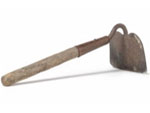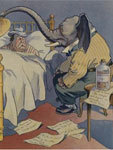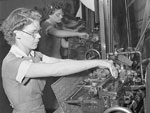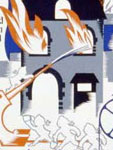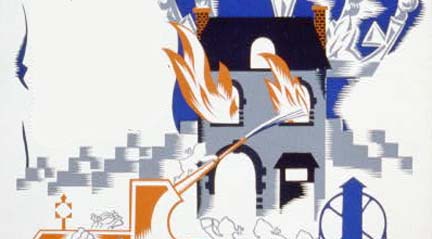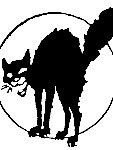Women's Suffrage Photographs
Video 1:
- Photo. Harris & Ewing. "Woman Suffrage Picket Parade." c.1917. Library of Congress Prints and Photographs Division, Reproduction No. LC-DIG-hec-10354.
- Photo. Harris & Ewing. "Woman Suffrage." c.1917. Library of Congress Prints and Photographs Division, Reproduction No. LC-DIG-hec-09404.
- Photo. Harris & Ewing. "Hitchcock, Helen. Woman Suffragette." 1914. Library of Congress Prints and Photographs Division, Reproduction No. LC-DIG-hec-04151.
- Photo. "Suffrage Parade, New York City." May 4, 1912. Library of Congress Prints and Photographs Division, Reproduction No.LC-USZ62-10845.
- Photo."Campaigning for the Vote" Collier's, September 28, 1912.
- Photo. "Demonstration of Protest and Mourning for Triangle Shirtwaist Factory Fire." April 5, 1911. General Records of the Department of Labor, National Archives. ARC Identifier 5730933.
- Photo. "Amalgamated Clothing Workers Strike." 1915. The Jacob Rader Marcus Center of the American Jewish Archives.
- Photo. "A Group of Suffragists Who Were Imprisoned For Picketing." Scribner's Magazine, June 1933.
- Notice. "Danger! Women's Suffrage would double the irresponsible vote! It is a menace to the Home, Men's Employment and All Business!" c.1912. Wisconsin Historical Society, Image Id: WHi-1932.
- Photo. "Marchers in Suffrage parade, 5/4/12 - Miss Brannan & Mrs. John Rogers, Jr." May 4, 1912. Library of Congress Prints and Photographs Division, Reproduction No. LC-USZ62-45057.
- Photo. Harris & Ewing. "Woman Suffrage. Suffragettes at Capitol." 1914. Library of Congress Prints and Photographs Division, Reproduction No. LC-DIG-hec-04534.
- Photo. "Edna Porter, as Everywoman." International Socialist Review, June 1916.
- Photo. "Edna Porter, Socialist Actress, in the folds of the Suffrage flag." The Progressive Woman, March 1910.
- Photo. "Dorothy Speaks In Meeting." American Magazine, February 1915.
- Image. "Trixie Friganza." Burr-McIntosh Monthly, May 1905.
- Photo. Bain News Service. "Suffragette Trixie Friganza, decending steps, New York." October 28, 1908. Library of Congress Prints and Photographs Division, Reproduction No. LC-DIG-ggbain-02465.
- Cover. "Don't forget! Columbia has her eye on you and expects you to vote for the good of the nation." Frank Leslie's Illustrated Newspaper, October 2, 1920. Library of Congress Prints and Photographs Division, Reproduction No. LC-USZC2-751.
- Cover. Phillips, Coles. "Maniacs or Martyrs? Willa Woman Die for Just the Vote?" Good Housekeeping Magazine, October 1913.
- Cover. Armstrong, Rolf. "The Mascot. Puck Magazine, February 20, 1915. Library of Congress Prints and Photographs Division, Reproduction No. LC-USZC2-1203.
Video 2:
- Photo. "German actress Hedwig Reicher wearing costume of "Columbia" with other suffrage pageant participants standing in background in front of the Treasury Building." March 3, 1913. Library of Congress Prints and Photographs Division, Reproduction No. LC-USZ62-70382.
- Photo. "Suffrage Dancers." c.1910–1915. Library of Congress Prints and Photographs Division, Reproduction No. LC-DIG-ggbain-15310.
- Photo. "Suffragettes - Inez Milholland Boissevain." Library of Congress Prints and Photographs Division, Reproduction No. LC-USZ62-132966.
- Photo. "Inez Milholland Boissevain, wearing white cape, seated on white horse at the National American Woman Suffrage Association parade." March 3, 1913. Library of Congress Prints and Photographs Division, Reproduction No. LC-DIG-ppmsc-00031.
- Photo. "Suffragette Parade." March 3, 1913. Library of Congress Prints and Photographs Division, Reproduction No. LC-USZ62-35138.
- Photo. Harris & Ewing. "Hitchcock, Helen. Woman Suffragette." 1914. Library of Congress Prints and Photographs Division, Reproduction No. LC-DIG-hec-04151.
- Photo. "Home Makers Suffragette Parade." March 3, 1913. Library of Congress Prints and Photographs Division, Reproduction No. LC-DIG-ggbain-11360.
- Photo. "Alice Paul, full-length portrait, standing, facing left, raising glass with right hand." September 3, 1920. Library of Congress Prints and Photographs Division, Reproduction No. LC-DIG-ds-00180.
- Photo. Harris & Ewing. "BURNS, MISS LUCY OF C.U.W.S." 1913. Library of Congress Prints and Photographs Division, Reproduction No. LC-DIG-hec-03458.
- Photo. Harris & Ewing. "'WOMAN SUFFRAGE. HEADQUARTERS, NATIONAL AMERICAN WOMAN SUFFRAGE ASSOCIATION.'" 1913. Library of Congress Prints and Photographs Division, Reproduction No. LC-DIG-hec-02086.
Video 3:
- Photo. Harris & Ewing. "WOMAN SUFFRAGE. SUFFRAGETTES WITH BANNERS." 1918. Library of Congress Prints and Photographs Division, Reproduction No. LC-DIG-hec-11371.
- Photo. Harris & Ewing. "WOMAN SUFFRAGE ARRESTS." 1917. Library of Congress Prints and Photographs Division, Reproduction No. LC-DIG-hec-09234.
- Photo. Harris & Ewing. "WOMAN SUFFRAGE. ARRESTS." 1918. Library of Congress Prints and Photographs Division, Reproduction No. LC-DIG-hec-11450.
- Program "Official program - Woman suffrage procession, Washington, D.C.. March 3, 1913." Library of Congress Prints and Photographs Division, Reproduction No. LC-DIG-ppmsca-12512.
- Engraving. "Ida B. Wells, head-and-shoulders portrait, facing slightly right." 1891. Library of Congress Prints and Photographs Division, Reproduction No. LC-USZ62-107756.
- Photo. Oscar Willis. "Ida B. Wells-Barnett, journalist and civil rights activist." New York Public Library Digital Gallery. Image ID: 1917533.
- Illustration. "Well, Missy! Heah we is!" Puck Magazine, March 13, 1913. Library of Congress Prints and Photographs Division, Reproduction No. LC-USZC2-1059.
How did the women's suffrage movement use the rise of journalism to its advantage? TJ Boisseau introduces photographs that show how suffragists staged protests with the press in mind. The photographs also reveal suffragists' debt to techniques used by striking women workers, the influence of new young leaders, and the racism that plagued the suffrage movement (and society at large).
What we have here are many photos of women publicly demonstrating. There are probably 200 articles about women demonstrating in public between 1900, 1910 and 1915. That's a good chunk, and a lot for historians to draw on. What you can do is you can juxtapose these photographs, one next to the other. Some of the photographs of women publicly protesting, marching in the streets holding signs, are going to be about women who are protesting work conditions for women—striking workers, for instance—others are specific to suffrage. What I would do with students is to talk to them about the differences in the photos and the continuities, so that you can see that the suffrage movement is taking lessons from the movement to protect women workers. Which is not always the same as the socialist movement, or the general workers campaigns, partly because major organizations are run by men and do not embrace women workers and do not attempt to protect them, nor do they see them as anything really but flies in the ointment. A spare population of workers who will work for less and will dilute the ability of men to demand better conditions and wages.
If we look at the striking women workers, and you can see where the techniques that the leaders of the suffrage movement, votes for women, took their cues. And one of the things they did—which is similar to the political cartoon that we just looked at—is they made sure that all the women looked fabulous. So they are wearing big hats and they were wearing as expensive clothes as they can afford, even when they are striking women workers. This did cause comment in the newspaper because it seemed in some ways to be a contradiction of terms. You're talking about how you can't really live on the salary that you make while at the same time you're trying to look like a leisured individual.
But for the most part it worked in this important way: it got their picture taken. And it made people attracted to and amenable to their message because they looked young and fresh and fashionable and they just seemed more appealing. This is at a moment when the public sphere was becoming inundated with images and the images in large part are of women. This is the emergence of cinema; it’s the emergence of advertising. So being able to look like those images that are held up as ideals for young women gave them an edge in the public consciousness; even if it created a kind of logical conundrum. It also made them sort of stand up straighter, feel proud, feel unified by their sex. It seemed to have a real centrifugal impact on their organizing.
I would point out that about the striking workers, and if you move from looking at the striking workers to looking at suffrage parades—which became a powerful way to get the public attention by about 1910 and certainly we're at the height of this in 1913—this becomes the talk of the nation.
What you see are dramatic displays where women are coordinated in their dress. White became a symbol of the suffrage movement, so they're borrowing from the traditional iconography of womanhood, they're borrowing the notion of purity, they're also borrowing from notions of white supremacy. It sort of works on a lot of different levels.
So in, for instance, 1913 you see at the head of that suffrage parade a very well-known, young, beautiful lawyer—female lawyer—who is dressed in white in a long, white, dramatic cape and is sitting astride a pure white horse. That suffrage parade is heading past the Capitol. The first public protest to ever petition the White House, to stand outside and demand attention in front of the White House—which is a familiar image now for early 21st-century Americans [because] this is what you do when you want attention and you want to call the powers that be on the carpet and you want to demand something from them—but the first one was a suffrage parade. And it was talked about as very controversial. Women were being bold. This was lead by two leaders—young leaders; a new generation of what's often referred to as militant suffrage women, because instead of working behind the scenes and working through contacts with powerful men, they went directly to the public. They also got arrested for what they were doing and also staged hunger strikes in prison, which also got them an enormous amount of attention.
They—Lucy Burns and Alice Paul—organized this particular one on the eve of the inauguration of Woodrow Wilson, the day before the inauguration. So they were very savvy. They knew the press was in town, they knew people were gathered there for the next day. And there was almost no one to greet the newly elected president when he stepped off the train because everyone was downtown watching the women marchers.
So they were very coordinated, they were all about using the press, and that's new. The press is relatively new, so it's not a surprise that 19th-century suffragists were not as able to take advantage of them—it simply didn't exist really until the end of the 1890s. It is the first time you really see the suffrage movement using that to its full advantage.
So this is probably the most famous photograph of women protesting outside of the White House. The text of their banners reads: "Mr. President, how long must women wait for liberty?" and "Mr. President, what will you do for women suffrage?" This is 1918, so it's at the end of Wilson's term as president and they had been waiting for Wilson to make a commitment in one direction or the other. And this is on the eve, of course, of the passage at the end of the year in 1920. You can see that they are boldly demanding, rather than politely asking. That too is a change in, not only the tactics of the suffrage movement itself, but kind of the tenor of public debate in the country. That there was an opportunity with urbanization and with increasing mass media—which became more and more, I'm sure some contemporaries thought vulgar, and other contemporaries thought frank and direct. There also is a frankness and a directness that's new to the suffrage campaign.
The parade that I was talking about was with women all dressed in white. Not all the women were dressed in white; some were dressed in academic regalia or their professional insignia to signify that these are a wide range of women from different backgrounds. That same parade allowed black women to march—at the back. And that was a, I'm sure, a very difficult moment for many of the people in the parade—for black women and for white women who had been committed to the principle of racial equality, which included many of the leaders of the suffrage movement who had made, I'm sure, some very painful compromises with that philosophy, hoping to bring Southern states, where the principle of Jim Crow and segregation was front and center throughout this time period. This is often talked about as the nadir of race relations in the United States and lynching is an issue that has been brought to the fore by black women such as Ida B. Wells-Barnett, who is at that parade—and refuses, in fact, to walk at the back and at the last minute just emerges out of the crowd and joins somewhere towards the middle to the front. That was also an exciting moment for Ida B. Wells-Barnett and for the history of the women's suffrage movement. Her defiance of the racism within the movement signaled an unwillingness of black women to take that backseat.
